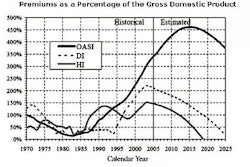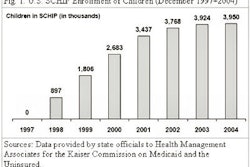There's no denying cardiac imaging is the next big thing in healthcare. In fact, a new guideline recently published in the American Journal of Cardiology (July 17, 2006, Vol. 98:2, pp. 2-15) recommends noninvasive screening with CT or ultrasound of all asymptomatic men between ages 45 and 75.
"Radiology is one of those fields where, when something new comes out, everyone has to have it," said Stacy Gregory of Gregory Medical Consulting Services in Tacoma, WA. "Consumers are well aware of the improvements in cardiac imaging technology. They want the latest noninvasive scan."
That's why the U.S. Centers for Medicare and Medicaid Services (CMS) and other payors watch reimbursement for cardiac imaging procedures so closely, she said.
"Heart image codes are among the most used -- which is probably why CMS put them on its most-watched list," said Walter Blackham, president of Lorain, OH-based Specialty Medical Services, in a presentation earlier this year at the Radiology Business Management Association (RBMA) 2006 Radiology Summit in Miami.
Payment problems straight from the heart
Compensation concerns associated with cardiac imaging is "one of the biggest issues in imaging today," said Dr. Shelley Weiner, a radiologist and senior medical director of radiology benefits management firm CareCore National in Wappingers Falls, NY.
"Technology is changing so fast and the rules are changing just as fast," said Diane Millman, an attorney with the law firm Powers, Pyles, Sutter, and Verville in Washington, DC, who represents the American Society of Echocardiography. "It's a 'now you see it, now you don't' world in terms of technology."
Because of this increased public interest, the American College of Radiology (ACR) and the American College of Cardiology (ACC) joined forces with Blue Cross Blue Shield to create new Category III Current Procedural Terminology (CPT) codes for cardiac imaging.
The new codes, which took effect in January this year, describe various common combinations of cardiac CT and CT angiography (CTA) studies, Gregory said. In most cases, a single code can be used to describe the combination of services performed.
Battle plans
Just knowing the codes, however, may not be enough to win you compensation for cardiac imaging procedures, warned Melody Mulaik, president of Powder Springs, GA-based medical coding education and consulting firm Coding Strategies.
Mulaik presented diagnostic coding conundrums at an American Healthcare Radiology Administrators (AHRA) audio conference earlier this summer.
"We are not seeing across the board that people are getting reimbursement for these procedures," Mulaik said. "It may be a really great procedure, but we're just beginning to find out what's being paid and what isn't in regards to CT/CTA coronary."
There are no relative value units for Category III CPT codes, Gregory said.
Physician reimbursement for these services is dependent upon the carrier fee schedule and local coverage determinations (LCD) requirements, she noted.
The majority of payors -- private and Medicare alike -- do not currently reimburse for CTA or calcium scoring, Gregory said.
Blackham said most payors do appear willing to pay for CPT code 0146T: computed tomography, heart, without contrast material, followed by contrast material(s) and further sections, including cardiac gating and 3D image postprocessing; computed tomographic angiography of coronary arteries (including native and anomalous coronary arteries, coronary bypass grafts), without quantitative evaluation of coronary calcium.
"Since it's the most popular study, it's probably also going to be the most watched, as well," he said.
Investigational trouble
"These examinations are still considered investigational procedures by many payors, carriers, and fiscal intermediaries," Gregory said.
Title XVIII of the Social Security Act, "Health Insurance for the Aged and Disabled," prohibits reimbursement for investigational or experimental procedures unless they fall under independent developmental evaluation or clinical trials policies, and all requirements for coverage are met, she said.
Without specific CMS guidance or instructions to the contrary, providers and other healthcare professionals should use Category III codes, by CPT definitions, for the purpose of tracking new and emerging technologies, according to Gregory.
"In most cases, medical benefits for these services have not yet been defined or validated," she noted.
Furthermore, there is no guarantee of reimbursement, she added.
Slicing the pie
Dr. David Dowe, a radiologist with AtlantiCare Regional Medical Center in Atlantic City, NJ, sees big financial challenges in cardiac imaging.
"It comes down to splitting the (radiology reimbursement) pie into smaller and smaller pieces for reimbursement money that is not there to begin with," said Dowe. "It's an insurance issue. Management is making it hell to get any exam, never mind a cardiac CT."
There are exceptions specifically described in various CMS instructions (change requests, manuals, or LCD), and individual considerations may be made by contractors, in which case the code may be billed and reimbursed according to that payor's fee schedule, Gregory said.
Those payors who do cover CTA have very specific policies, clinical indications, and criteria that must be met to receive reimbursement for the procedure.
Mulaik suggests researching the payment practices of the top 10 payors in your area to find out if they offer payment for cardiac imaging; and, if so, how they structure the reimbursement procedure.
"Don't rely on rumors about who's paying for what," she said. "Do the research."
"The papers are saying that this (cardiac imaging) is extraordinary, that it's a miracle," Dowe said. "Soon it will be that everyone 30 or 40 or older will have a heart scan as part of their routine physical. But how are we going to pay for that?"
By Melissa Varnavas
AuntMinnie.com contributing writer
August 4, 2006
This article originally appeared in the "Radiology Administrator's Compliance & Reimbursement Insider," a monthly newsletter published by HC Pro that is designed specifically for radiology administrators. For a free trial subscription, please click here.
Related Reading
Guideline proposes mass cardiac screening with imaging, July 11, 2006
The added value of ACR accreditation, June 13, 2006
Unlock success with strategy, research, April 27, 2006
Preparing for a JCAHO visit, April 18, 2006
Dealing with HIPAA changes in 2006, April 6, 2006
Copyright © 2006 HC Pro



















